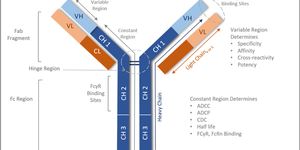Microprotein Mutations May Significantly Increase Alzheimer's Risk
The mitochondrion, commonly called the powerhouse of the cell, might be one of the best known organelles. This special organelle is thought to have once been a symbiont that infected another cell, and helped give rise to complex life. Mitochondria still carry their own tiny little genomes and make some of their own proteins. There have been a variety of disorders linked to mutations in mitochondrial DNA; these diseases tend to affect muscle. But now, researchers have found that a mutation in a mitochondrial gene that encodes for a microprotein called SHMOOSE might have an important link to Alzheimer's disease. In this study, the researchers used computational tools to find genetic variants in mitochondrial DNA that were linked to changes in the risk of disease. The findings have been reported in Molecular Psychiatry.
SHMOOSE is known as a microprotein, and when a mutation happens in the gene encoding for it, the microprotein is partially inactivated. The mutation has been associated with a 20 to 50 percent increase in the risk of Alzheimer's disease in several cohorts of people. About one-quarter of people with European ancestry carry a mutant version of SHMOOSE, according to this study.
Variants or mutations in the APOE4 gene are among the most significant Alzheimer's genetic risk factors we currently know of; most of the other genetic risk factors that have been identified for the disorder are only causing small increases of under ten percent. The study authors noted that the SHMOOSE mutation is commonly observed and can cause a substantially increased risk, which differentiates it from other genetic risk factors.
The SHMOOSE microprotein seems to normally be involved in metabolism and energy signaling in the brain and spinal cord. Levels of SHMOOSE were also found to correlate with Alzheimer's disease biomarkers. Additional work indicated that SHMOOSE can influence energy metabolism in the central nervous system by interacting with the inner mitochondrial membrane.
The researchers also noted that since SHMOOSE is a microprotein, it could be useful as a therapeutic.
"This discovery opens exciting new directions for developing precision medicine-based therapies for Alzheimer's disease, focusing on SHMOOSE as a target area," said senior study author Pinchas Cohen, a professor at the University of Southern California. "Administration of SHMOOSE analogs in individuals who carry the mutation and produce the mutant protein may prove to have benefit in neurodegenerative and other diseases of aging."
More research will be needed to confirm these findings, and learn more about the role of microproteins in the body. Researchers are still trying to determine which microproteins are functional, and there are many candidates. This approach could also offer a better method to reveal which microproteins are important.
Sources: University of Southern California, Molecular Psychiatry









